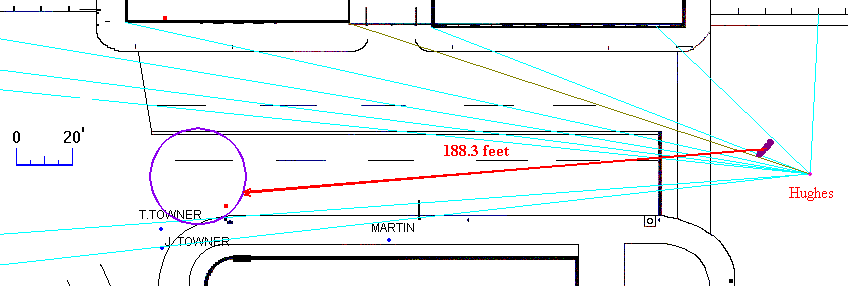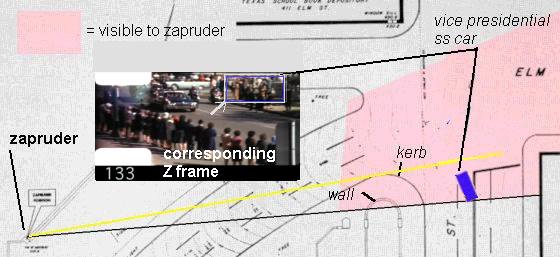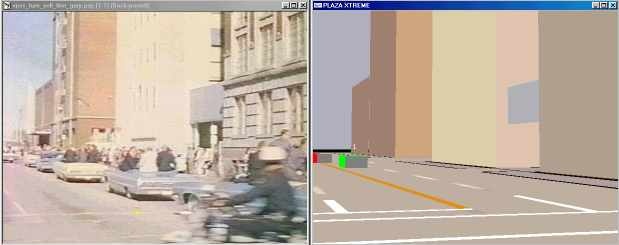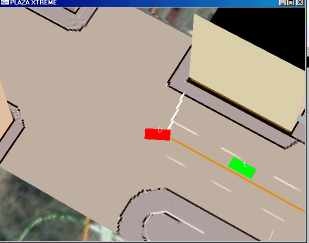
return to start of this section
The results of this analysis, applied to the relevant Hughes frame, are presented here in the following java applet , which gives the distances up Houston Street of the cars in the motorcade seen in the Hughes frame. The applet automates the procedures described previously, and depends for it's accuracy on the fact that Houston Street is, in relevant part, flat & horizontal.
In parallel to the 'chess board' problem, we must evaluate the 'invariant' for the Hughes frame - this means that we must input at least one known measurement. If we can locate Hughes accurately, at the time he took that frame, then we will know his distance to (say) the nearby cross-Houston white lines, and, from this we can get that 'invariant', and thence all distances along the flat surface of Houston Street. The derivation of Hughes's location is sketched here.
The initial, top, picture represents two Hughes frames, spliced together. (There are two other frames available). The right half of the picture is the Hughes frame we are interested in. The blue lines represent the (easily found) converging parallels in the picture, which enable us to find Hughes' horizon (red horizontal). (There is another vanishing point far off to the right, way out of the picture.) The first interactive element is the blue slider at the right of the picture, which enables control of an effective measuring device. The black near-horizontal, on the road surface, should be aligned with whatever pictorial element (that touches the visible road surface) it is desired to locate. The white numerical read out in the picture itself gives the distance of that point from the third of the three cross- Houston white lines, measured straight up Houston Street. The caption (below the photo) gives both this measurement & the measurement right back to Hughes's camera. The map shows the location of the reference line, across Houston St.
Thr second, red, slider next to the map (bottom picture) allows interactive movement of Mr Hughes, in order to see how his position affects the results.
Aligning the black reference line (in the photo) with the back of the LBJ SS car (in the distance, cropped, just left of the centre of the picture ) gives a distance- to-white- line measurement of 169 (+- 4.5) feet when Hughes is placed 63 feet from the thick cross Houston reference line. The map / plan then shows where the back of that car has to be on Houston. This puts the car far enough north up the street to be into Zapruder's field of view. Thus, assuming our location for Hughes, this section of the Hughes film coincides with the frames of the Z film showing the car in that location. or further north by up to 8 feet . (IE Z frames 133 + ).
Note : You will need a screen resolution of 1024 X 768 or better to be able to use
the applet below without difficulty. If the screen below becomes garbled due to scrolling, hiding, or resizing
this window, clicking 'refresh' on your browser's toolbar should solve the problem.
An application to Don Thomas's Interpretation of H20
The Most Acoustics Friendly Version Compatible With The Analysis
Comparing with the map below, we can see that the LBJ follow up, as seen in the Hughes frame, & even using the furthest position back down Houston Street compatible with the analysis presented here, is indeed far enough north up Houston St. to be caught by Zapruder's camera, at about frame 133, meaning that it is highly unlikely McLain could possibly have reached the Houston - Elm corner in time to record any acoustic 'events' as discussed by Bolt Baranek & Newman, since this implies he travelled around 188 feet in 2.295 secs [ time from this Z frame to the first acoustic 'event' = (175 - 133)/18.3 secs] a speed of around 56 mph.


At the time Z frame 133 (above) was shot, Mclain was taking the Main-Houston corner .
View the relevant frames of the Hughes film here
Below are some screen shots from an OpenGL 3D software reconstruction of H20, compared to the actual movie frame, with a view of the identically configured scene beneath it, as an aerial view. The green & red boxes represent the leading 2 cars in the film frame.

